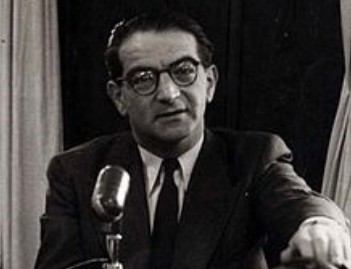
British Jewish historian Paul Bogdanor has published a new book “Kasztner’s Crime,” in October about the role of the controversial wartime Zionist leader, Rudolf Kasztner. His goal in his 10 years research was to prove Kasztner’s innocence, but he was extremely shocked when all his research data pointed towards Kasztner’s having been “a collaborator” with the Nazis, and a “betrayer of the Jewish people.”
Kasztner was a Hungarian attorney who led a small Zionist group in Budapest towards the end of World War II. He headed a Jewish rescue committee which, before the Nazis entered Hungary, did succeed in saving the lives of a number of Jews. But once the Nazis arrived, Kasztner became the main liaison negotiating with Eichmann.
Kasztner succeeded in getting the Nazis to agree to the deportation of a group of 1,684 Hungarian Jews, the so-called “Kasztner Train,” who eventually ended up in freedom in Switzerland and which contained many of his relatives. But it turns out that the price was sending hundreds of thousands more on the doomed path to Auschwitz.
Bogdanor says that not only did Kasztner know they were being sent to their deaths, but that he actively kept such information secret from other Jews in Hungary and the wider Jewish world and took steps to mislead both Jews inside Hungary and his Jewish contacts in the outside world.
For example, “on May 14, 1944, he sent a letter [out of Hungary] saying that Auschwitz was merely an industrial center, not an extermination camp, and later on he sent letters saying that the Jews deported from Hungary were alive and well in Waldsee, which was the Nazi camouflage for Auschwitz.”
Bogdanor says the Nazis “saw how attracted he was to power. He went gambling and drinking with the Nazi officers. He was their tool — but he also knew he was being used as their tool.”
Kasztner was “drawn into this web of collaboration by degrees. Part of it was his own sense of aggrandizement and vanity. Kasztner’s rescue committee were the only Jews in the country who did not have to wear a yellow star and continued to use their own cars and telephones.”
A court case held in Israel in 1955 to defend Kasztner from accusations of collaboration ended up condemning him, with the chief justice saying he had sold his soul to the devil. The government appealed the verdict, and the Supreme Court reversed the ruling.
Bogdanor says that that reversal was based on “a fundamental distortion of the evidence in the trial” by Judge Shimon Agranat. He had argued that at every crucial point, Kasztner was not yet sure that the Nazis intended to murder Hungary’s Jews but “in the very passages [from the trial evidence] cited by Agranat, Kasztner said that he was sure that the Nazis intended to exterminate the Jews of Hungary.”
Bogdanor says that Kasztner’s defenders’ claim that he had rescued thousands of Jews “ are without substance, whatsoever.
Paul Bogdanor says he constantly asked himself during the decade it took him to write the book, “Am I wrong? Am I sure?”
“But yes,” he concludes. “I am as sure as it is possible to be. Kasztner was guilty.”
